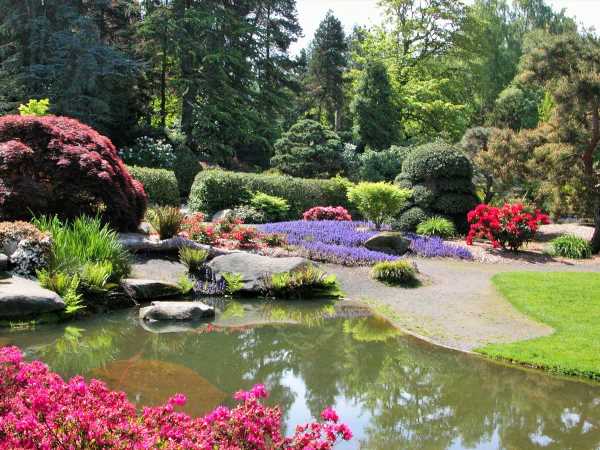Visiting the former homes and gardens of our predecessors is one of the best ways to fully explore the lives (and design styles!) of those who came before us. And, with May being Asian American and Pacific Islander Heritage Month, it’s a great time to take a look at some of the most impressive—and fascinating— residences of and landscapes designed by members of the AAPI community. Below, take a look at our wide-ranging list, which includes sites like the Iolani Palace in Honolulu, a Noguchi-designed garden in Costa Mesa, and more.
Kubota Garden, Seattle, Washington
Located in Seattle, Washington, the Kubota Garden is a Japanese-style landscape that boasts 20 acres of colorful scenery—which includes a moon bridge, a common facet of both Japanese and Chinese gardens. Since 1987, it has operated as a public park run by the Kubota Garden Foundation and the Seattle Parks and Recreation. This space was created by Japanese-American gardener and philanthropist Fujitaro Kubota in 1927, five years after he founded his own gardening business in Seattle.
Yin Yu Tang House, Salem, Massachusetts
© Wikimedia Commons
the yin yu tang house
Since 2003, the Yin Yu Tang House has been open to the public as part of the Peabody Essex Museum in Salem, Massachusetts. The abode itself is a re-erected 18th-century house from the Chinese province of Anhui. It is the only work of Chinese vernacular architecture in North America.
The Isamu Noguchi-Designed California Scenario at South Coast Plaza, Costa Mesa, California
In 1979, Japanese-American artist and landscape architect Isamu Noguchi was commissioned to create a small plaza at the South Coast Plaza in Costa Mesa, California. The result? A prize-winning space known as the California Scenario, named for its depictions of characteristics typical of Californian topography, as well as the presence of plants from this region.
Iolani Palace, Honolulu, Hawaii
© Jon Hicks – Getty Images
gettyimages-520266740
The Iolani Palace served as a royal residence for numerous Hawaiian dynasties from 1845 to 1893—and for the past 43 years, it’s been open to the public for visitors near and far to admire. Following the overthrow of the Hawaiian monarchy in 1893, this structure served as the capitol building for the Hawaiiian government for the next 76 years. This site is also the only royal palace in the U.S.
The Astor Chinese Garden Court at the Metropolitan Museum of Art, New York, New York
Although it’s not part of an historic house museum, the Astor Court is part of one of the world’s most famous sites: the Metropolitan Museum of Art. This space—which is also known as Ming Hall—is a recreation of a Chinese courtyard from the Ming Dynasty era, and it was built with the help of Chinese craftsmen, under the vision of Met trustee Brooke Astor. When Astor Court was completed in 1981, it became“one of the first cultural exchanges between the United States and the People’s Republic of China,” according to UNESCO.
Polly Bemis House, Idaho County, Idaho
© Wikimedia Commons
the polly bemis house
Even though it’s not open to the public, the Polly Bemis House in Idaho County, Idaho is surely a site worth seeing. It was once home to Chinese-American pioneers Charles and Polly Bemis, the latter of whom is perhaps best known for writing a biographical novel that was later transformed into a film: A Thousand Pieces of Gold (1991). This dwelling was added to the National Register of Historic Places in 1988.
Follow House Beautiful on Instagram.
Source: Read Full Article
